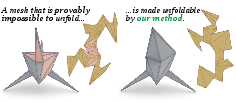- The paper presents a method that strategically alters mesh geometry using vertex repositioning and edge collapses to achieve overlap-free unfoldings.
- The approach significantly improves success rates, achieving 92.42% on 500-face meshes and 84.10% on 1000-face meshes compared to traditional methods.
- The method's practical applications are validated by fabricating physical models, demonstrating its potential impact on computational design and manufacturing.
Mesh Simplification For Unfolding
Introduction
The paper "Mesh Simplification For Unfolding" (2408.06944) puts forward a computational approach for isometrically unfolding 3D shapes into a plane as a single patch without overlapping triangles. The complexity of this problem arises from the fact that many 3D shapes do not naturally allow for such an unfolding. Traditional methods that tackle this problem often relax it by allowing for multiple patches or introducing distortions, which compromises the fabrication process. The authors propose a novel geometric relaxation technique that modifies the shape itself. By displacing vertices and collapsing edges, the method ensures that the shape admits an overlap-free unfolding.

Figure 1: Existing methods fail at consistently producing simple, non-overlapping unfoldings of complex shapes (middle). Instead, our method finds a close approximation to the input shape that admits a simple unfolding (right).
Methodology
To address the challenge of unfolding arbitrary shapes, the authors focus on altering the geometry until it is unfoldable in a single, non-overlapping patch. This approach hinges on two main strategies: vertex manipulation and mesh decimation.
- Vertex Manipulation: The method begins by moving vertices to locally resolve overlaps in the unfolded mesh. Different vertex movements are considered based on local geometric conditions.
- Mesh Decimation: Edge collapse operations are prioritized based on their contribution to overlap resolution. The method maintains a valid spanning tree to ensure that the unfolding remains coherent and minimally different from its pre-collapse state.

Figure 2: The potential single-patch unfoldings of a given mesh can be represented by the spanning trees of its dual graph.
Algorithm Steps
- Initialization: The algorithm starts with an initial unfolding generated by either Takahashi et al.'s genetic algorithm or Zawallich et al.'s Tabu-search approach. These unfoldings are often not overlap-free.
- Vertex Repositioning: Through a combination of geometric energies and surface flow, vertices are gradually repositioned to minimize overlaps without altering the overall topology.
- Mesh Simplification: The algorithm iteratively performs edge collapses that preserve the spanning tree of the unfolding. It avoids creating non-manifold vertices or self-intersecting geometries.
- Post-Processing: Once an overlap-free unfolding is achieved, a post-processing step optimizes the mesh to revert it closer to its original form without reintroducing overlaps.

Figure 3: Our algorithm is composed of several steps, all of which are crucial to obtaining a single patch unfolding that is non-overlapping.
Evaluation and Results
The technique was validated on datasets narrowed from Thingi10K by mesh decimation to either 500 or 1000 faces. The evaluation involved comparing the success rates and computational times against existing methods. The authors report a significant increase in unfolding success rates of models which could not be processed by traditional methods without shape modification.
Quantitative Results:
- For coarse meshes consisting of 500 faces, the success rate increased from 40.24% (Takahashi) to 92.42%.
- On fine meshes with 1000 faces, it increased from 10.55% to 84.10%.
Fabrication Validation:
The algorithm was used to fabricate physical models, such as a fox and a plumber model, from paper. This practical outcome underscored the method's application in manufacturing settings.

Figure 4: We carry out the clearest validation of our algorithm by utilizing it to generate physical models of a fox and an Italian plumber from pieces of cut paper.
Conclusions
The paper presents a robust approach to achieving single-patch, non-overlapping unfoldings of complex 3D shapes. The method strategically modifies the shape, offering significant improvements over previous techniques, especially in practical scenarios requiring precise material fabrication. Although the approach offers substantial advancements, it occasionally fails for certain complex inputs, indicating room for future refinement. Moreover, the potential for integrating edge glueing capabilities and addressing user-specified patch constraints opens avenues for expanded applicability in diverse fabrication processes. Overall, the proposed method represents a meaningful stride toward solving a longstanding problem in computational design and fabrication.



